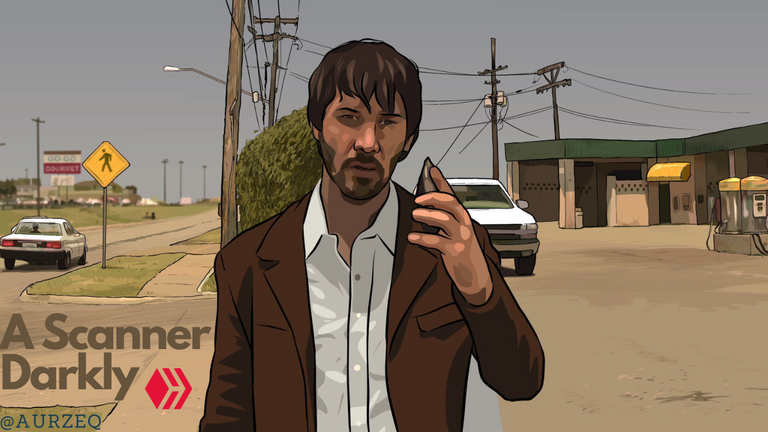A Scanner Darkly - a great animated psychological sci-fi thriller movie ahead of his time

Source

Index
Click on the desired section to move there directly

Introduction
Today, social networks, fake news, and popular photographic filters among teens, in particular, have taken over how we perceive the world. We are no longer able to build an accurate impression of our surroundings, we constantly have a tendency to doubt our sources, and we are unable to interact honestly with the pictures that are always around us. The cinema of recent years has not shied away from simulating this identity crisis as a result of all this media disorientation and visual pollution.
These themes and aesthetic forms were certainly not innovative or groundbreaking when "A Scanner Darkly" debuted in 2006, but they did not receive widespread approval from critics and the general public. This is possible because they were projected into a reality that had not yet accepted everything that had just been mentioned. Simply, "A Scanner Darkly" was cast too far in advance of its time. Re-watching the movie today makes it easier to identify with the dystopian reality it depicts and, as a result, to feel more sympathy for the characters.

Source
press here to scroll back to the index

Adaptation of a book
Richard Linklater, the director of the movie, used a Philip K. Dick book as an idea for his movie.
The movie maintains the perspective Dick developed in his book. In fact, the 1970s were challenging for the author since it got harder and harder to tell the difference between truth and fiction.
In order to gain some highly intriguing insights and observations, Linklater's film makes advantage of Dick's fixation with the crisis of the individual and the subject in a society that is becoming more and more controlled by dangerous reactionary tendencies. The film, which features a stellar cast including science fiction icon Keanu Reeves, Robert Downey Jr., Woody Harrelson, Winona Ryder, and Rory Cochrane, manages to convey paranoid and disturbed feelings to the viewer despite a few instances of heavy static. It does this by tenaciously utilizing the potential of the experimental technique promoted by the director and the stability of a screenplay that purposefully stays within reasonable bounds from the book's original idea.

Source
press here to scroll back to the index

Rotoscoping technology
Colors and shapes blend to produce an animated work that resembles a graphic book more than a traditional one. One is initially mesmerized by the odd graphic style, but then the focus turns to the few bizarre characters that inhabit the little world of "A Scanner Darkly." The dialogues are well-written, and many of them are the result of endless ramblings brought on by the effects of the "D-substance," effects that the protagonist will also experience. As a result, the action drags on throughout the entire movie before coming to a satisfying conclusion at the very end.
A live-action movie with the uncertainty of how to make the infiltrators' camouflage suits would have produced a far different effect than the delirium of images produced by the rotoscoping technology.

Source
press here to scroll back to the index

Drug addiction
The entire vision of Linklater's picture is, if possible, even more, unsettling than the dystopia of Blade Runner since it gives a highly realistic portrayal of drug addiction and immerses the audience in a futuristic society that is all too plausible and connected to reality. The 'cartoony' appearance of the rotoscope technique and the characters' constant excitement create a hallucinogenic effect because the story is told from the perspective of a drug user. As D-substance takes control of their lives and causes them to loose touch with reality and their own identities, the characters find themselves philosophizing about frequently pointless debates.
Even though Bob Arctor and his friends occasionally suffer terrible twists in their hallucinations or absurd situations, their main feelings are almost always perverted amusement and uneasiness.
The actors have no trouble boosting the mental states of their characters, who are no longer able to tell what is real from what is hallucination. Linklater pays close attention to their introspection with a sober but rigorous directorial cut, where close-ups and tight shots rule supreme to bring viewers closer to the burnt-out psyche of the protagonists. The dreary backdrop of a California where 20% of the population is a heroin addict completes the image of a movie that is as harsh and cynical as its abrupt and uncomfortably abrupt climax.

Source

Plot
The movie tells the story of Bob Arctor, a Los Angeles narcotics agent who, in a not-too-distant future infiltrated the junkies in search of the enigmatic and lethal drug. Robert Arctor eventually develops an addiction to the drug. He spends his days having crazy, nonsensical chats with his drug-addicted friends Jim Barris (Robert Downey Jr.), Ernie Luckman (Woody Harrelson), Donna Hawthorne (Winona Ryder), and Charles Freck (Rory Cochrane).
His dual role and the effects the drugs have on his brain lead Arctor to lose touch with reality gradually.
press here to scroll back to the index

Conclusion
A movie that is highly recommended, especially to fans of the genre, of the author, or those seeking something more intellectually stimulating than a straightforward movie.
press here to scroll back to the index

Rating
My personal vote is:
8.5/10
press here to scroll back to the index

Farewell image and text separators, created by me with Canva
Yay! 🤗
Your content has been boosted with Ecency Points, by @aurzeq.
Use Ecency daily to boost your growth on platform!
Support Ecency
Vote for new Proposal
Delegate HP and earn more
Oh yeah,a great movie for sure! Very disturbing on so many levels.